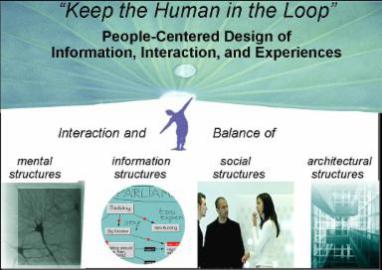Smart Future Initiative
The Smart Future Initiative (SFI) was founded in January 2009 by
Dr. Dr. Norbert Streitz, a Senior Scientist and Strategic Advisor with more than
35 years of experience in information and communication technology.
He was previously (among other affiliations) Division Manager and Deputy Director of the Fraunhofer-Institute IPSI, Darmstadt, Germany, and is now the Scientific Director of SFI.
Goal
The goal of the Smart Future Initiative is to establish a forum and network for triggering, developing and communicating innovative ideas and concepts as well as providing expertise on technology
developments and trends determining our current and future life in a fast changing society. While the emphasis is on trends and developments in information and communication technology (ICT), our
work is grounded in a multi- and interdisciplinary approach considering also social sciences as well as architecture, design and art. The overall guideline is a
Human-Centered Design Approach, respectively in the application domain of Future Cities, a Citizen-Centered Design Approach and
To Keep the Human in the Loop and in Control. This can be achieved by designing for a well-understood Human-Technology Symbiosis for Reconciling
Humans and Technology.
Design trade-offs play an important role for managing the diverging demands of "human control and being in the loop vs. automated or autonomous systems" as well as "usable privacy vs. importunate smartness". It results in the vision of moving beyond "smart-only cities" by "Re-Defining the Smart-Everything Paradigm".
Focus
While all areas of ICT are contributing to the overall goal, we focus on Smart Environments, Ambient Intelligence, Ubiquitous and Pervasive Computing (including the
Disappearing Computer concept), and the Internet of Things (IoT) as steps towards Smart
Ecosystems.
These technologies are becoming de facto key dimensions of the emerging information and knowledge society, because new generations of industrial digital products and services are clearly shifted towards the vision of a comprehensive smart ecosystem environment.
Another important dimension is the use and combination of these technologies with a variety of application domains, e.g., mobility and transportation, work, home, leisure, entertainment, education, health care, social engagement and responsible citizenship.
For all these application areas, it is important to address the issues of
privacy in sensor-based environments via the Privacy by Design approach.
The context is provided by the umbrella scenario of Urban Life Management in future Hybrid Smart
Cities, Airports and Islands to be designed as Humane Urban Environments in order to reconcile humans and
technology. The goal is to develop and facilitate a Humane, Sociable and Cooperative Hybrid City, where "quality of life" is a key objective so that citizens can
exploit their human potential, lead a creative life, get involved in the community and contribute to a resilient and sustanainable environment.
Multidisciplinary Approach
The multidisciplinary approach is especially reflected in a strong emphasis on placing people and social contexts at the center of our considerations and recommendations for future technology
development. An important guideline is "keep the human in the loop." This implies to overcome a purely technology-driven approach by taking multiple disciplines into account. We argue for a
collaboration of computer scientists and electrical engineers with psychologists, ergonomists, product and interaction designers, architects, artists and representatives of other disciplines that
play a role for a specific application domain under consideration. This approach implies the following two requirements:
First, it requires to take a close look at human-human communication, coordination and collaboration and the resulting implications for the design of human-computer interaction or more general
human-artefact, resp. human-environment interaction. A key aspect is the increasing shift from information design to experience design.
Second, it requires to take a comprehensive perspective on a wide range of application settings and scenarios starting with smart artefacts and smart rooms, continuing to smart and cooperative
buildings, public spaces, urban environments, etc. and putting it all together in the context of cities, metropolitan areas and regions as well as islands. At a grand scale, we have to consider
countries and nations and their societies. The guiding objective is a Citizen-Centered Design Approach and the ambition of developing Humane and Sociable Cooperative Hybrid
Cities within the overall framework of Reconciling Humans and Technology moving beyond "smart-only" cities.



